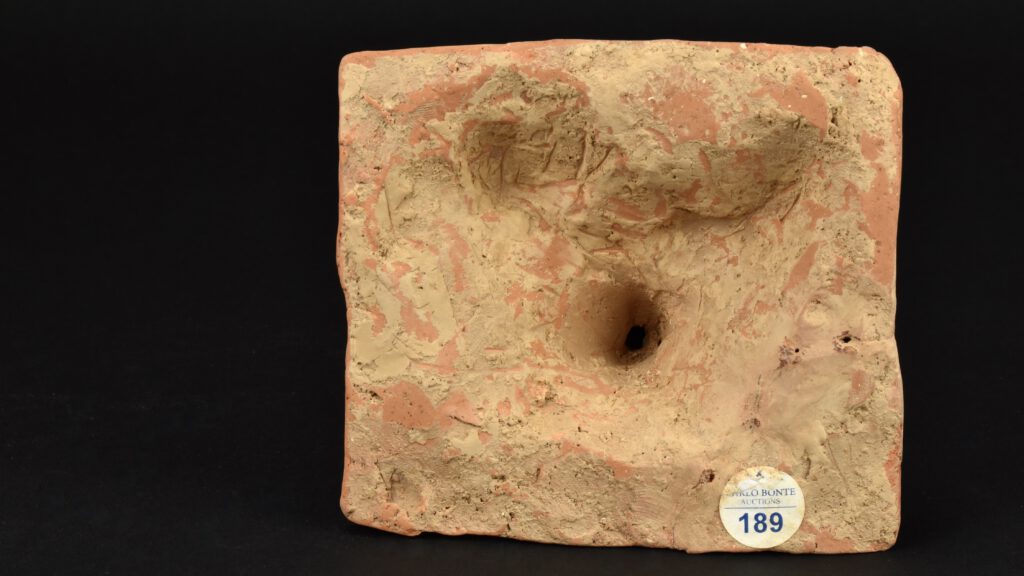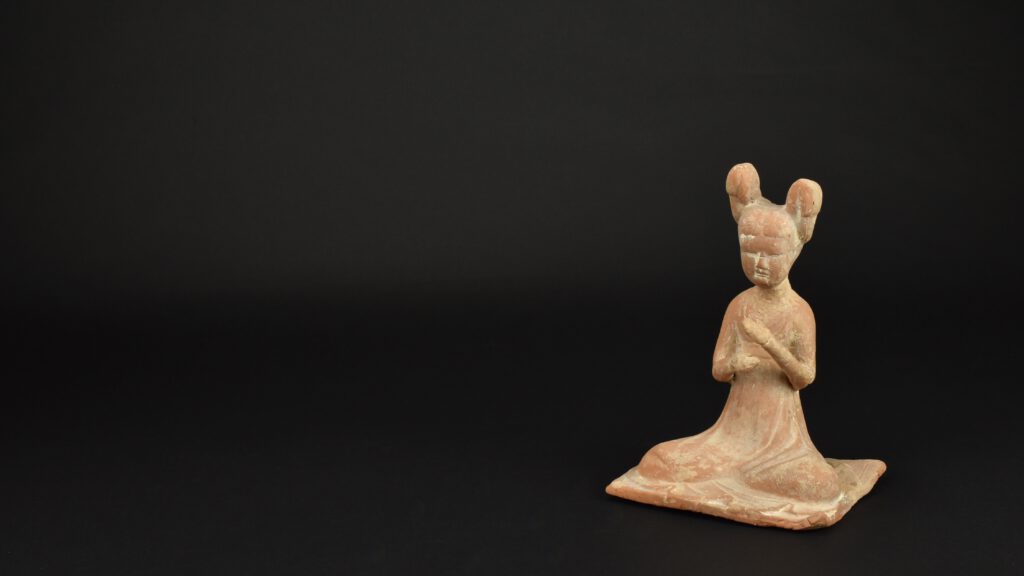
Tang Dynasty Pottery Musician 7th Century
A Tang Red Pottery Model of a Musician, North China, 7th Century. This is a classic Tang model and was much copied in the early 20th century and subsequently. The woman is depicted seated on a square mat, her legs tucked behind her, the pleats of Qun (skirt) are neatly arranged around her. For more details about women’s clothes from the Tang Dynasty see below. This lady would have probably been playing gudi flute. There are remains of white paint and traces of an orange-red pigment to the base at the back.This figure is an example of Mingqi, objects made specifically for burial, to be taken with you to the afterlife. The `Terracotta Army` is the most famous example of this type of burial object. Mingqi objects represented people, houses, farms, granaries, livestock and indeed anything important from this world that would give you comfort and status in the next. The `Terracotta Army` were made life size and on a vast scale, reflecting the importance of the first emperor of China but most Mingqi objects were small models, far smaller than the object or indeed person they were meant to represent. Mingqi ceramics were not the only goods to appear in early Chinese tombs, objects that functioned were also buried, some of these had clearly been worn or even damaged, presumably these objects were prized possessions belonging to the deceased that might have been used on a daily basis. This figure has a photocopy of the Thermoluminescence Analysis carried out on 18th January 1988. However, in my opinion this figure doesn’t need a test.
See Below For More Photographs and References.
SOLD
- Condition
- Her flute is missing and both hands have been restored, the head has been reattached throw the neck. The back right corner has been reattached.
- Size
- Height : 18.8 cm (7 1/2 inches).
- Provenance
- Marc Michot, 1988, (Belgium), photocopy of the Thermoluminescence Analysis (18th January 1988), the back of the photocopy has a photograph of this Tang figure. Label for Carlo Bonte Auctions, lot 189 on the base.
- Stock number
- 25832
- References
- For a very similar Tang cymbal player see : Fine Chinese Ceramics, Bronzes and Works of Art, Sotheby`s London, 9th December 1986, lot 66. The catalogue states "A lady playing the cymbals and in the same pose is included in the group of musicians and dancers with the same coiffure and robes unearthed in 1976 at Xucun..". This was the tomb of Li Shou in Sanyuan, Shaanxi province. For a similar pair of Tang Dynasty musicians see : see : Chinese Ceramics from the Meiyintang Collection Volume 1 (Regina Krahl, Azimuth Editions, 1994) page 113, items 185 and 186. A seated Tang figure dated to the 7th century, with straw glaze who was once playing a flute is in the Matsuoka Museum of Art Tokyo, Japan. A similar figure of a seated Tang dancer is in the Fitchburg Art Museum.
Information
Robert McPherson Sold Archive :
A Pair of Tang Pottery Musicians, Late 7th to Mid 8th Century. The Elegant Musicians Depicted Seated with Lose Robes and the Hair Divided into Two High Chignons at the Side of the Head. One is Playing Bo, Small Cymbals, While the Other Holds up Her Hands to Play a Dizi, a Bamboo Flute (Now Lacking).
Condition : Bo Cymbal player : Large section of the base re-stuck through her left knee, head re-stuck. Dizi Bamboo flute player : Flute now lacking, both hands re-stuck, head re-stuck.
- Size : Height (without stand) : 19 cm (7 1/2 inches)
- Provenance : Purchased in June 1952 from Spink and Son, London. A Private European Collection of Early Chinese Ceramics.
- Sold Archive : 21384
- References : For a very similar Tang cymbal player see : Fine Chinese Ceramics, Bronzes and Works of Art, Sotheby`s London, 9th December 1986, lot 66. The catalogue states "A lady playing the cymbals and in the same pose is included in the group of musicians and dancers with the same coiffure and robes unearthed in 1976 at Xucun..". This was the tomb of Li Shou in Sanyuan, Shaanxi province. For a similar pair of Tang Dynasty musicians see : see : Chinese Ceramics from the Meiyintang Collection Volume 1 (Regina Krahl, Azimuth Editions, 1994) page 113, items 185 and 186.


Early Tang Women's Clothing

Tang Dynasty Skirt ; Jianse Qun














